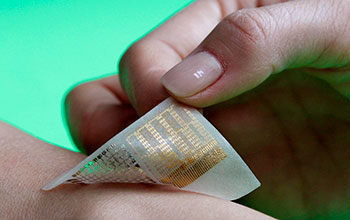Multimedia Gallery
Prototype wearable electronic skin patch
A prototype wearable electronic skin patch that's as thin as a temporary tattoo and can store and transmit data about a person's movements, receive diagnostic information and release drugs into skin.
Although there have been other efforts by researchers to develop "electronic skin," this device is the first with the capability of storing information and also delivering medicine, combining patient treatment and monitoring.
The device was developed cooperatively by Nanshu Lu, a mechanical engineer at the University of Texas at Austin, and Dae-Hyeong Kim of Seoul National University in South Korea. The researchers layered a package of stretchable nanomaterials onto a material that mimics the softness and flexibility of skin. The resulting sticky patch houses a device roughly 4 centimeters long, 2 centimeters wide and 0.3 millimeters thick that contains sensors, RAM capabilities, microheaters and medicine.
The patch must adhere to skin through electrostatic force because using an adhesive would disrupt electrical connectivity.
"This technology could help electronics that interact with humans be more mechanically compatible," Lu. "In terms of application, its uses range from consumer products like rollable displays and solar cells to personal digital health care like EKG and emotion sensors to computer gaming."
Lu received support from a National Science Foundation grant (CMMI 13-01335) to study the mechanics at the bioelectronics interface. The researchers reported their findings in Nature Nanotechnology. (Date of Image: October 2013)
Credit: Donghee Son and Jongha Lee
See other images like this on your iPhone or iPad download NSF Science Zone on the Apple App Store.
Images and other media in the National Science Foundation Multimedia Gallery are available for use in print and electronic material by NSF employees, members of the media, university staff, teachers and the general public. All media in the gallery are intended for personal, educational and nonprofit/non-commercial use only.
Images credited to the National Science Foundation, a federal agency, are in the public domain. The images were created by employees of the United States Government as part of their official duties or prepared by contractors as "works for hire" for NSF. You may freely use NSF-credited images and, at your discretion, credit NSF with a "Courtesy: National Science Foundation" notation.
Additional information about general usage can be found in Conditions.
Also Available:
Download the high-resolution JPG version of the image. (2.5 MB)
Use your mouse to right-click (Mac users may need to Ctrl-click) the link above and choose the option that will save the file or target to your computer.

